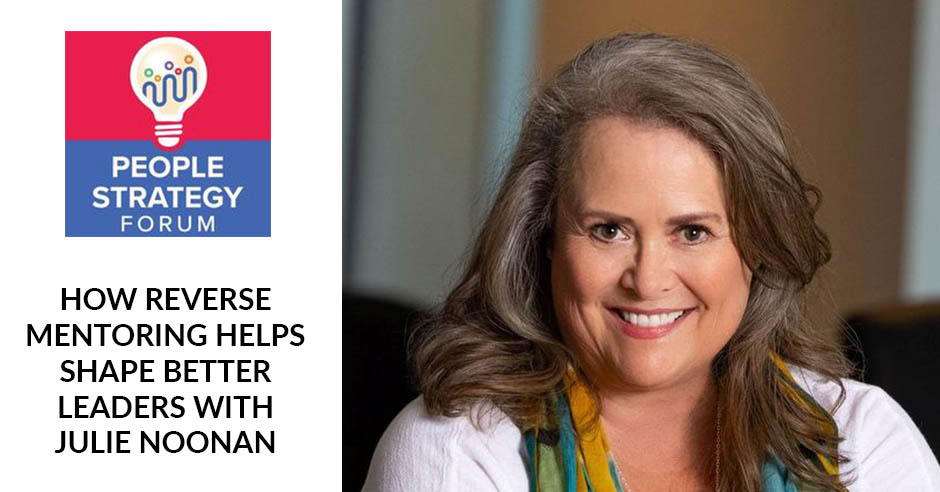How Reverse Mentoring Helps Shape Better Leaders With Julie Noonan

Leadership approaches must constantly be changed and innovated to achieve better results and stay relevant to the ever-evolving landscape. Julie Noonan is here to introduce the concept of reverse mentoring, which promises better leadership development. She shares how this method can help different generations do value assessment, find common ground, and come together in effective collaboration. She discusses how this approach is important now more than ever after COVID-19 accelerated the conversation about generational gap, work-life balance, and hybrid workplaces. Julie also explains why reverse mentoring is not all about the number of meetings and why it is not advisable to be applied on a manager-employee level.
—
How Reverse Mentoring Helps Shape Better Leaders With Julie Noonan
We’re a show that guides leaders to elevate their overall workforce. We provide those practices and guidance for you to improve your overall workforce experience. We believe that people are at the heart of successful organizations. Also, team members’ well-being, rewards, and career development are essential to a happy, healthy, and highly productive workforce. This show discusses practical and effective leadership strategies for top executives, senior professionals, and talent managers.
As part of our regular hosts, we have Howard Nizewitz. He’s a Senior Seasons Compensation Advisor and a Strategic HR Advisor as well. He has over 30 years of experience in a lot of large companies. I’ve been privileged to have him help me and mentor me in my practice as well. Thank you, Howard, for that.
Also, we have Char Miller. Char Miller is a Human Resource Consultant, Business Owner, and Chief HR Officer of Rocky Mountain Health Advocates. I know Char as a serial entrepreneur because she has a couple of her own businesses as well, such as Mountain and Sea Career Strategies and Mountain and Sea Health Advocacy. Reach out to her for those pieces of information as far as career counseling and health advocacy. She’s known as HR with a heart. I’m very fortunate to have Char on as well. Thank you, Char.
Also, myself. My name is Sam Reeve. I am the Founder of CompTeam. We’re a global compensation and talent management consulting company. I focus my efforts on preparing small to mid-size rapidly growing talent-centric organizations on implementing competitive pay programs and those talent programs that help them such as career architecture and so forth. I’ve been in this business for over 25 years now and have helped companies across 23 countries and 5 continents. I love it. It’s a lot of fun.
We are here to introduce you to Julie Noonan. This is going to be a great thought-provoking conversation that will challenge your perspectives and inspire meaningful change in your organization. I’m going to say a little bit more about Julie. She has a genuine love for people. She has a talent for idea generation. She’s been on 30 different shows so far. What truly sets her apart is her unwavering commitment to creating real relationships and understanding the needs that are beneath the surface.
With years of executive consulting, expertise, and dedicating to learning and growth, our guest is here to share her expertise in reverse mentoring. It’s a topic that promises to revolutionize the way that you approach leadership and foster collaboration in your organization. Without further ado, let’s dive into the conversation with the incredible Julie Noonan. Thank you so much for joining us on the People Strategy Forum, Julie.
Thank you very much for having me. I’m excited to be here to share this message.
What we do to get things kicked off is would love to hear a little bit more about your experience and how you got into consulting and helping the people that you help.
I started out as an English major, so nothing whatsoever to do with anything, honestly. One of the things that I figured out once I decided that I didn’t want to be a college professor with the suede on my sleeves and I wanted to make some money and not eat macaroni and cheese forever, was that the study of English literature was a study of human behavior under crisis. That’s when I figured out that I loved change management. I loved being able to watch people and to intuit, “This is why they’re acting that way.” I could intuit what they were going to do next. I could also figure out, “How can I help them engage with this change? How could I help them have a better outcome?”

Reverse Mentoring: The study of English literature is the study of human behavior under crisis.
I got into change management relatively quickly coming up through the Learning and Development organization, I went into leadership development fairly quickly after that and I started out in Corporate America, went through a banking industry, tons of mergers and acquisitions later during the ’90s and early 2000s. I then went into consulting.
Through consulting, I was very blessed. Because of consulting, I got exposed to so many different companies, so many different sizes of companies, also private companies, public entities, nonprofits, you name it. I had the experience of being able to see how those different entities operated. I was able to say how blessed I was in experiencing all of those different cultures.
After my consulting days, I went into state government for 5 years, and then I turned 55 and got laid off. That was the first turning point in my life when I was 55. When you’re 55, you’re turning a little gray, you’re a woman, and you get laid off, you hit ageism face-to-face. All of a sudden, there aren’t so many recruiters calling you.
I thought to myself, “I have hired plenty of independent contractors. I’ve hired plenty of affiliates to come in and help me.” I do nothing with compensation, by the way. I’ve hired plenty of compensation experts because God forbid anybody let me near their numbers. Certainly, somebody would hire me to come in and do change management for them as an independent contractor.
I put out my shingle. I did several projects, but then as soon as I had the opportunity to go back into consulting, I jumped at the chance. I went back into a full-time consulting gig and COVID hit. I got laid off again at 57. At that point, I said, “I’ve got to stand in my power. I have to take control of my own life.” That’s when I formed my company as it stands right now. I have never been happier. I’ve never been more successful in my life. I am so happy and surrounded by support. I can’t say enough about being independent at this point. That’s where I am.
You’re an inspiration, Julie. I have a Facebook group called Freedom From Corporate. As a person who’s been laid off a couple of times, it’s very scary to become an independent contractor, consultant, entrepreneur, etc. I’m very proud of you and I think that you’re an inspiration. Congratulations on making that successful and living your dream.
Thank you very much. I’m trying to inspire younger women, particularly women, to stand in their power and literally give it a shot. It’s very hard, but it’s very worth it.
Agreed. Especially, during times of such change, there are so much of things that are going on in the world that create instability. Whether it’s the economy, inflation, or the job market going up and down. It’s nice to be able to at least be in control of your own. I can understand the appeal there for sure. What I would love to dig into a little bit more is you mentioned that you did a lot of M&A activity in your career. Part of our discussion is reverse mentoring and so forth. What have you learned about the M&A environment and how different generations flex to that particular environment?
M&A, mergers and acquisitions, that was a little earlier in my career before reverse mentoring, so I haven’t worked M&A with reverse mentoring. I want to be a little cautious in that regard. From a mergers and acquisition perspective, what I saw that was most successful was when we went in as change managers and change leaders. The most successful mergers and acquisitions projects that we went in on and I was on the due diligence teams, were the ones where we actively had leaders that paid attention to the cultures.
The ones that simply paid attention to the numbers, to the systems, to the logistics, to your basic business operations type things. Didn’t pay attention to the people, didn’t pay attention to the communities in which some of these businesses, they were banks mainly, operated. The deals that they had with their communities, when they didn’t pay attention to those cultures, they stumbled.
The most successful mergers and acquisitions projects were the ones with leaders who paid attention to cultures instead of the numbers or logistics alone. Share on XOne of those in particular was a bank in the Northeast and a bank in the South. The culture clash was like Hiroshima. It was not pretty at all. The numbers looked beautiful. The systems looked like they were going to be gorgeous. Even the people at both banks, at least at the leadership level, looked like a marriage in heaven. The problem was the communities. The community that the Northern Bank serviced wanted nothing to do with a Southern Bank. They didn’t want that friendly yeehaw. They didn’t want the Southern banker in their business.
That was something from a risk assessment perspective that was missed in the due diligence effort. That caused that merger to not go well. It probably added a good two years before that evened out. The toll on the people or the employees within that bank was horrendous. As a change manager, it was very stressful.
I grew up in financial services and have witnessed that firsthand because you go through quite a number of mergers and acquisitions. That culture piece and the engagement piece are so often overlooked. I’ve seen horrendous, within a year losing key people that we should have been able to retain. The focus is always on the numbers and the logistics. They miss the whole people part of it.
You probably know what merger I’m talking about.
I do.
When we think about that and change management overall, we use change management and also the different generations in helping with that, reverse mentoring, how does that come into play?
Right now, especially after COVID, I studied the generational divide. It’s been around for quite a while, obviously. People started talking about that. I know that I gave a presentation in Austin to the organization development network back in 2007 about the generations, the generation gaps, and the number of generations in the workforce. It’s not a new topic.
What happened though with COVID, it brought the different values of the generations to the forefront because COVID accelerated the younger generations’ values. With remote work in particular, it wasn’t an option anymore. All of the younger generations and I have always thought, “Why do I have to go in the office?” For a lot of people, remote work was something that should have been happening already. For a lot of people, diversity and inclusion have been talked about for many years.
I was trained as an HR person in a large bank. I was trained in the early 2000s with a fairly stringent diversity program. These things had been coming up, but they were slow. Work-life balance was slow. COVID put it right in front of us and it accelerated those conversations for our good, but it hit some people in the face.
When I started to get into my practice during COVID, when I was talking to my clients and when I was talking large corporations as well as individuals who I provide executive coaching for, a lot of times what was coming up was I don’t know how to deal with this other generation. Whether I was speaking with high potentials who didn’t know how to deal with the Boomers and the early X-ers or vice versa.
I don’t know how to deal with this other generation. The generational conversations were bubbling up faster than they had previously because it was right-back interfaces. That’s when I stumbled back upon, “How am I going to help these people?” That’s when the idea of reverse mentoring crept back into my psyche. I started thinking about it differently.
When you’re in that experience, when you’re guiding organizations, what are the main issues that you see between the different generations that have been common recently?
I’ll give you a good example. I’m working with a very large pharmaceutical organization. I started working with them years ago right after I started my company. The very first thing that I noticed, and this was a new group, they had a contingent of a legacy group. They’re a knowledge management group, so they were made up of some corporate librarians. On top of that, they had some scientific researchers. These individuals were young and out of Ivy League schools. Very innovative, computer savvy, technology savvy, interested in artificial intelligence, machine learning, the whole 9 yards. This was years ago. It was even before ChatGPT and all this other stuff.
I’m looking at this group, and they were now under one team. They were supposed to be collaborating on a new knowledge-sharing platform, building it for the organization. They had no idea how to work together, none whatsoever. Thus started the they-them finger-pointing. How classic is this? The first thing that I did was get to know all of them and start to watch and listen for their perspectives on things without asking any questions and without passing judgment. Start to look in on their project meetings, and listen for those judgmental cues. Finally, I said, “Why don’t we do some team building?” This was all virtual, unfortunately, because this was during COVID, we couldn’t get together.

Reverse Mentoring: The first step of reverse mentoring is watching and listening to the perspectives of your team without asking questions or passing judgment.
I found an instrument called the Barrett Personal Values Assessment for $20. You can’t beat that. I had all of them take this assessment. I compiled the results and anonymized them. As a team, we went through it together and we focused first on where this whole team had values that were the same. We went through and discussed these values that are all the same. This is the mission of the organization and this is the mission of the group. How are we as a team going to accomplish this mission? Once we had our goals set out, then we started talking about what the biggest differences are and how we are going to get around those. After that, it was fine.
The big thing was you used those values assessments to find common ground. It started causing some connections, “Maybe we’re not so different after all,” type of thing.
It’s not rocket science, but yeah.
It’s easy to see the differences in people when we’re talking to one another. The problem is first developing a relationship with one another where we can talk about those differences in a safe space where we can have that collaborative conversation. What are the most common challenges that you see in that transition?
Once we get the common differences, what happens after that is they begin to allow themselves to have some vulnerability with each other. Some, on a personal level, they’ll make those personal connections. At that point, I was able to identify, “We have a couple of these individuals over here on the Boomer side or the older side who are very uncomfortable with technology.” They don’t want to say that out loud because for them, it’s embarrassing. They work in a digitally enabled. It’s career-limiting or it could be. I was able to identify that.

Reverse Mentoring: Once a team faces their common difference, they begin to allow themselves to have some vulnerability with each other.
On the other side, I’ve got individuals who have never been exposed to a political situation and organization where you need to know how to maneuver politically and how to position yourself so that you can be seen. There are some cultural situations here where being seen is not necessarily a cultural positive. In the culture that some of these individuals come from, humility is a big factor. We’ve got some learning opportunities on both sides, so I was able to match some of these individuals up into reverse mentoring partnerships.
I would sit in on the first sessions to make sure that they understood what the partnership should look like. This wasn’t a performance review situation. It was completely confidential, so none of it should go back to either one of them’s bosses. I was not there to be a tattletale to the boss, none of that. It wasn’t a project review. It was literally, “You, Joe, tell you, Mary, what you would like to work on, and vice versa, and you help each other.” That’s it. It worked beautifully.
Was there a written agreement? What are the mechanics of how you made it happen?
I allowed them to decide that. For some people, once it’s a written down agreement, it becomes able to be passed along to HR and it was intimidating that way. A couple of the teams decided they would write it down just because they wanted to be able to be reminded and accountable. A couple of them didn’t and I was fine with either way they wanted to do it. I left it in their hands. I didn’t take the written papers or anything. The only metric that I had was at the end, I asked them if they had found value in the relationship or not. That was my metric. Unanimously yes. That was good.
I’ve been in charge of learning and development departments, etc. too. I love this concept. This is fantastic. I’m curious, for my personal clarity, when you talked about AI, you’ve got a Boomer, no offense to any Boomers out there, who might not be comfortable with AI. I got to figure out AI, I got to train too, and I’m an X-er. By the way, the X-ers are the forgotten people. If you’re an X-er, you know what I mean.
I do know Gen Zs and Gen Ys. You’re also spot on because there’s zero tolerance for bureaucracy, “I’ve worked here for 30 years. You don’t know what you’re talking about because I have a history with this company. I’ve been here forever.” It’s a real turnoff to younger generations. We’ve been hearing words like the quiet-quitting generation.
To me, that sounds like labeling a generation. What I love about this though is we all have value. Believe me, I don’t care what age we are. I love the fact that you’re aligning. We have value and we can align our values. I love that. Here’s my question for you then. The reverse mentoring technique, is that only for a colleague-to-colleague standpoint? Do you utilize it for the management employee different levels as well? Is it mainly more of a colleague?
I do not put manager and subordinate. The reason is that there’s already a dynamic there that doesn’t work. Let’s say for instance my client here is an executive vice president. If my client here wanted to engage in reverse mentoring, I would find someone who is not his subordinate. I would find someone in another person’s group who would like to engage, and I would make that agreement between them.
I’ve also worked with large systems. I’m going to use some cliché. Let’s say the Chief HR Officer and the Chief Financial Officer, the two different ends of the spectrum. I was often told that HR people need to improve their business acumen when it comes to finance, money, and numbers. As HR, ladies are our people, men, and anybody, is what you’re recommending for that type of mentoring situation? Which would help to reduce the silo effect, which often happens, particularly in large organizations where the seniors are not partnering and supporting one another? What do you think about that?
Not necessarily, because what I’m talking about is generational first and skills second. If it’s generational first, then sure. If one of your skills is, “I want to learn more about finances,” then maybe I would partner you up with somebody who is maybe like a junior person in accounting. I could do that. I certainly wouldn’t put a CFO and a Head of HR together. That’s just asking for a headache.
Does it help build more of those cross-functional relationships in organizations?
Exactly. The reason why I’m saying that is because one thing that I was saying with Sam before everybody got on was each generation is brought up with certain things. I was brought up as a Boomer. I’m the last of the Boomers.
I’m right behind you.
I was brought up with a very high degree of competition. We were brought up to compete with everybody. We did not collaborate, especially women. We had knives in our hands and would stick them in each other’s backs to crawl up the ladder.
Women had knives in their hands and would stick them in each other’s backs to crawl up the ladder. Share on XThat’s quite a visual.
I had to learn to collaborate. To me, the very first thing, when I think of collaboration, I think it’s going to take longer and it’s going to be messy. I sigh. I don’t have time to collaborate. That’s my visceral reaction to collaboration.
It takes mental energy.
It takes mental energy. I’ll just do it myself. That is literally my first reaction. Generations behind me were brought up collaborating. Their first reaction is, “Let me go and get a group of people and we’ll figure this out.” I don’t want to put somebody like me with another person like me, because we’ll fight with each other because I’m going to be right and they’re going to be right. I’ve learned to collaborate and I enjoy collaborating now. However, I know that I can use either skill depending on what needs to happen at the moment. That’s called being well-rounded. That’s what we want to teach them how to do as well.
I get that a lot. I see that in my children. They have a different mindset especially when it comes to sports. They’d rather be in a team sport than an individual sport. They’re more social than I ever was, so it’s very interesting. Andre is asking a question here. Does collaboration take an awareness and accept us as being interdependent?
We are learning more about how interdependent everything is. We are moving as a culture from being this fierce, independent, cowboy, entrepreneurial, bar-the-doors, I’m-going-to-get-what-I-want culture to now, “Let’s do this all together,” kumbaya stuff. We’re on this pendulum. We’re on the Kumbaya side right now. Will it swing back the other way? I don’t know.
The bottom line is, it takes both. Sometimes it takes the person plowing through to get something done. It also takes, while you’re doing that, the recognition that, “I might be plowing through, but what am I leaving in my way?” Sometimes it takes, “We all have to go together or this isn’t going to be successful.” I have to have 8,000 people’s opinions change Management 101 to make this happen. It’s all interdependent. It’s not an either/or. It is a both situation.
Going back to when you formed these reverse mentoring groups, these people who are getting together, one of the critiques I’ve heard about this particular process is that you miss a meeting and then it all falls apart. Meaning that people stop meeting with one another and they forget about it. What do you do to keep this alive and to have some accountability here?
Let me put it this way. When it dies, it dies. One of the things we need to let go of is measuring success by how long we can keep something alive. If it’s not working, it will die. The bottom line is, “What is my measure of success?” My measure of success is the reverse mentoring relationship will last as long as each person is getting value out of it. That’s as long as it needs to last.

Reverse Mentoring: Success in reverse mentoring relationships will last as long as each person is getting value from it, and that’s as long as it needs to last.
I love that, Julie. Thank you for that. It’s always important to make sure that the door stays open where people can feel like they can talk to one another, but creating value is what this is all about.
A lot of times, I love data. Data is the big thing right now. Data is the king and everybody wants data. Let’s make sure we’re looking at the right data. The right data is not, “How many weeks did this relationship last?” That’s not the right data. The right data is, “What value or did this person realize value out of this relationship, yes or no?” That’s the data.
In your role as a coach to leadership, you bring this up as a tool to help with a particular situation. I imagine there’s a time when you say, “It sounds like we need to have another reverse mentoring session that we need to do based on something that happens in the future.”
Maybe you need another person.
As far as measuring, because that’s another thing leaders say, “How do we know if we’re getting anything out of this? What is the thing that you can show leadership that this is working for an organization and this had value to the organization?”
Truly, it depends on the competencies and the goals that each person decides that they need out of the relationship. It could be something as simple as the level of comfort with AIML. I’m using that as an example because one of my people, that’s one of their goals. I want to increase my level of comfort with AIML. I said, “Why don’t we use a scale of 1 to 10, how comfortable are you right now before we start this thing?” They put themselves at a four. At the end, in the middle, or whenever we decide we want to measure it again, we’ll measure it.
When we go to talk with the leadership about, “Are you making progress?” not only will the leader talk to the person and say, “How are you feeling about it?” We’ll have some measures. Maybe they’ll be up at a 6 or maybe they’ll be up at an 8, but they’ll also be able to say, ” I’m feeling more comfortable,” or, “Now when I think about joining a project with AIML involved, I feel like that I can add value to that project.” It’s not always about numbers.
I know that we’ve talked a little bit about the workshops and grouping people and so forth, but for our audience out there, can you tell us a story about where this was transformational for one of your clients and how it felt for them?
My second client pair, one of them used to be a COBOL programmer. He’s a little bit older than me. His claim to fame was building a system that was the first of its kind at an organization many years ago. He inherited a group of individuals that were very cutting-edge. He was charged with leading them to create a system that is going to do the same thing that the system he created did back then but doing it now with the whole pile of data. He was nervous about it because they were all in a huddle. They were coming up with lots and lots of ideas. They were using some terminology that he wasn’t quite familiar with. Although, he’s a learner. He was trying to keep up with the latest and greatest, he hadn’t been in school for years. He shared some of his hesitations with me.
I said, “If you’re up for it, why don’t we see if we can get the project leader on his team who does not report to him?” This is a project manager from a vendor, so no reporting relationship. “Why don’t we see if he would be willing to engage in a reverse mentoring situation?” He was with no fee. Yay for me. We agreed for a short period of time to help him get his confidence back up and engage in this reverse mentoring relationship. He had very specific goals, so he was able to do that. They met individually once a week after the actual project meeting. This person focused on helping him get up to speed.
What he did for that person was help him because he was relatively young in his position at the consulting company and my client had been in consulting. He was helping him with his executive presence. He was in the role of account executive, and it was his first time, so he was helping him with his account executive role. It was an interesting dynamic and it went swimmingly well. They were both very happy at the end of it.
One other thing that I’d like to mention is that we’re talking about tools earlier. One of the tools that we often interface as one of our sponsors is the TMA method. This is a way to learn a little bit about each other. It’s one of those assessment tools that you can start with. It’s also a whole program and integrated talent management. One of the big pieces that you can use in reverse mentoring is to have a conversational piece to have that discussion and start to know one another and talk to one another about some of those commonalities and some of those things that made you different. The TMA method is a great way to make that happen.
Also, one thing that I want to make sure that I bring up is my new book The Workforce Experience. This is available now on Amazon. If you want to go out to Amazon and take a look at this. We talk about a lot of the different things about how to enhance the employee experience at companies to better attract, retain, and motivate the workforce.
Reverse mentoring is a way where we can build more teaming and increase workforce cohesion. Go out there and take a look at that. Julie, I want to bring up this one other question we had from our audience. How did you get started in doing what you do? How did you go through the process, get clients, and starting your consulting practice?
I did the easiest thing. I circled back to everybody I had ever known and said, “I hung out a shingle. You all know what I can do. If you know of anyone or if you have a need, I’m available and would love to talk to you.” I had takers right away. Don’t neglect your network. Even when you’re fully employed, don’t neglect that network. Get on LinkedIn and make sure your profile is up to date. Get your badges, keep learning, and keep yourself up to date.
Great advice.
I give my career coaching clients that all the time. We get comfortable in our positions even if we’ve been there for thirteen years. One day, you get the pink slip maybe, something gets changed. It’s out of our control and we have to have that up to date. Good advice.
Don’t take it to heart if you get laid off. It happens and it’s not you. It’s not your fault. Just remember that you are valuable to somebody always.
Don’t take it to heart if you are laid off. It happens, and it’s not your fault. Remember that you are always valuable to somebody. Share on XThere are so many outside factors, business changes, shadow departments, etc. You and I know this. It is devastating if you get laid off. I like to hear you say that and that you’re a great support to those individuals.
Anybody that’s laid off, support somebody else who’s been laid off.
Julie, for our audience out there who have questions or would like to learn more about your practice or learn more about reverse mentoring, how do they get ahold of you?
Probably the easiest thing is my website, JNoonanConsulting.com. That’s the easiest way to get ahold of me. I’m on LinkedIn, so link in with me.
Thank you so much for the conversation.
Thank you. I appreciate it very much.
Real pleasure, Julie.
Thank you, Char. Thank you, Howard. Thank you, Sam.
Enjoy. Thank you everyone for joining us on the People Strategy For and we’ll see you in the next episode. Take care.
Important Links
About Julie Noonan

Julie Noonan, CCMP, CPC is a Change Strategist and Executive Coach who believes in unapologetic authenticity, candor, integrity and humor.
Julie has years of executive-level experience in consulting in both the private and public sectors, as well as years of experience as a corporate employee. She has spent her career coaching leaders at all levels in many industries and through many challenges – both professional and personal.
A few of her strengths include:
- Intuition to “feel” the culture and energy in an organization to guide adjustments needed to better align with mission
- Talent for idea-generation that helps her clients expand their thinking and innovation
- Keen focus on maximizing others’ talents
- Ability to recognize the inherent connections between concepts, disciplines, ideas and people to create better solutions.




